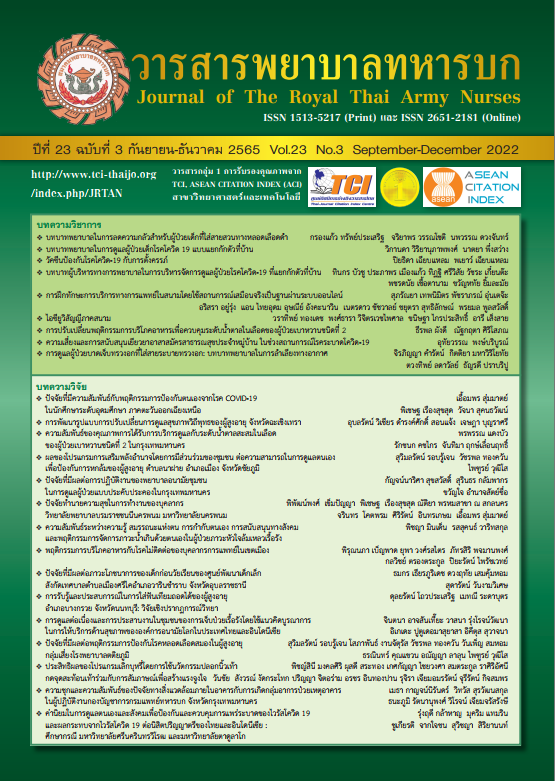บทบาทพยาบาลในการลดความกลัวสำหรับผู้ป่วยเด็กที่ใส่สายสวนทางหลอดเลือดดำ
คำสำคัญ:
บทบาทพยาบาล, ลดความกลัว, การใส่สายสวนทางหลอดเลือดดำบทคัดย่อ
หัตถการพื้นฐานที่ผู้ปวยเด็กต้องได้รับเมื่อต้องเข้ารับการในโรงพยาบาล คือ การใส่สายสวนทางหลอดเลือดดํา มากถึง ร้อยละ 95 เป็นหัตถการที่ใช้เพื่อตรวจวินิจฉัยและรักษาโรค เช่น การฉีดยา การให้สารน้ำ ซึ่งการใส่สายสวนทางหลอดเลือดดํา ผู้ป่วยเด็กมองว่าเป็นสถานการณ์ที่คุกคาม เนื่องจากเจ็บปวดจากการถูกทําลายเนื่อเยื่อบริเวณที่ใส่สายสวน และความเจ็บปวดนี้เป็น สิ่งคุกคามและเป็นปัจจัยหลักที่ทําให้ผู้ปวยเด็กเกิดความหวาดกลัว ส่งผลให้ไม่สามารถใส่สายสวนสําเร็จได้ ดังนั้นพยาบาลซึ่งเป็น บุคลากรที่อยู่ใกล้ชิดผู้ปวยเด็กมากที่สุดและมีบทบาทที่สําคัญมากที่ทําให้การใส่สายสวนทางหลอดเลือดดําสําเร็จได้ นอกจากพยาบาลจะต้องมีทักษะและความชํานาญแล้ว พยาบาลจะต้องทราบบทบาทหรือวิธีการที่จะช่วยทําให้ผู้ปวยเด็กลดความกลัวในการใส่สาย สวนทางหลอดเลือดดําอีกด้วย บทความวิชาการนี้มีวัตถุประสงค์เพื่อป้องกันการเกิดความกลัวที่ผิดปกติจากพัฒนาการของ ผู้ปวยเด็กลดความเสี่ยงในการเกิดอันตรายจากการใส่สายสวนล่าช้าและสร้างความตระหนักให้กับพยาบาลในการปฏิบัติกิจกรรม การพยาบาลทีช่วยลดความกลัวในการใส่สายสวนทางหลอดเลือดดํา
Downloads
เอกสารอ้างอิง
Alisa S, Sanae K, Monta U. Dealing with the Fear of Stabbing Pain Pediatric Needles: Nursing practice in caring for pediatric patients. Journal of The Royal Thai Army Nurses. 2017; 25-31. (in Thai)
Khamenkan K. “Intravenous cannulation Procedure in Pediatric Patients: Nursing Strategies to success Pediatric Saline Stabbing Procedure: Nursing Strategies for Success” Journal of Nursing Science and Health. 2012; 35(2): 131-139. (in Thai)
Wilson D, Hockenberry MJ, Wong DL. Wong’s clinical manual of pediatric nursing. 2012.
WHO. Pocket book of hospital care for children: Guidelines for the management of Common childhood illnesses: Geneva, Switzerland : Second edition, edition. 2013.
Salmela M, Aronen ET, Salantera S. The experience of hospital-related fears of 4 to 6 year-old children. Child: Care, Health & Development. 2011; 37(5): 719-26.
Wipada S. Adaptation to stress of sick children using play. Journal Science and Technology. 2010; 20(5): 449-456. (in Thai)
Koller, D., Goldman, R. D. Distraction techniques for children undergoing procedures: a critical review of pediatric research. Journal of Pediatric Nursing: Nursing Care of Children and Families. 2012; 27(6): 652-681.
Muris, P. Normal and abnormal fear and anxiety in children and adolescents. Elsevier. 2010.
Rumai J, Duangkamol M, Kanyawee K, Suwaphan T. The distraction in combination with the environment for the fear of intravenous fluid exposure of preschool aged patients. Journal of Thai Nursing and Midwifery Practice. 2018; 5(2): 55-68. (in Thai)
Patchmon K, Chanadda N, Phornphat H. Effects of humorous media programs Against the fear of school-age children receiving intravenous fluids. Journal of the Faculty of Nursing, University Burapha. 2021; 24(2): 61-71. (in Thai)
Piaget, J. The child and reality. 1973; pp: 16-17.
Hockenberry, M. J., Wilson, D. Wong’s nursing care of infants and children. 2015.
Natchanan C. “The role of nurses in reducing anxiety from separation from preschool children.” Journal of Phrapokklao Nursing College-Journal of Phrapokklao Nursing College Chanthaburi. 2016; 27(2). (in Thai)
Lazarus, R. S., and Folkman, S. Assessment of acute pain and anxiety in children and adolescents by self-reports, and behavior checklist. Journal of Consulting and Clinical Psychology. 1984; 52(5): 729-738.
Chaiyawat W, Mary A.J. Thai School-Age Children’s Perception of Fear. Journal of Transcultural Nursing. 2006; 17(74): 74-81.
Gullone, E. The development of normal fear: A century of research. Clinical psychology Review. 2000; 20(4): 429-451.
Patchmon K., Chanadda N.,Phonphat H. “Effects of the use of humorous media on the fear of school-age children receiving intravenous fluids.” Journal of the Faculty of Nursing. Burapha University 24.2 (2021): 61-71.
Sucha C. Child Psychology. 3rd printing, Bangkok: Thai Wattana Panich Printing House.1998. (in Thai)
Behar, D, Stewart, M.A. Prevention of suicide. Pediatrics. 1981; 67(6): 933-934.Bogart B, Campbell J, Lopez C, Smith L, Viaud B. Reduction procedural pain in children. Journal of Pediatric Nursing. 2011; 26:e2.
Wong, C. Y., Cheng, R. S., Lataief, K. B., Murch, R. D. Multiuser OFDM with adaptive subcarrier, bit, and power allocation. IEEE Journal on selected areas in communications. 1999; 17(10): 1747-1758.
Nicastro, E. A, Whetsell, M. V. Children’s fear. Journal of Pediatric Nursing. 1999; 14: 392-402.
Lininnger RA. Pediatric IV issertion success rate. Pediatric Nurs. 2003; 29(5): 351-4.
Cuper, N. J., De Graaff, J. C., Van Dijk, A. T., Verdaasdonk, R. M., Van Der Werff, D. B., Kalkman, C. J. Predictive factors for difficult Intravenous cannulation in pediatric patients at a tertiary pediatric hospital. Pediatric Anesthesia. 12012; 22(3): 223-229.
Rodriguez L. Pathophysiology of pain: implications for perioperative nursing. AORN Journal. 2015; 101(3): 338-344.
Kanyawee K, Waraporn C. Effects of concrete-multiple choice information. together with the participation of Mothers against fear of intravenous fluid exposure in preschool children. Journal of Nursing Chulalongkorn University Journal of Nursing science Chulalongkorn University. 2016; 28(2): 25-34. (in Thai)
Suchada P, Somorn R, Patchanee S. Application of the concept of fear management. In preschool children receiving intravenous fluids. Journal of Humanities and Social Sciences Nakhon Phanom University. 2018; 196-202. (in Thai)
Bogart B, Campbell J, Lopez C, Smith L, Viaud B. Reduction procedural pain in Children. Journal of Pediatric Nursing. 2011; 26(2)
Muris, P. Normal and abnormal fear and anxiety in children and adolescents. Elsevier. 2010.
Thanyawan K, Weena J, Noraluk U. Effects of preparation on pediatric patients in combination with the use of Computerassisted instruction program on cooperative behavior in receiving intravenous solutions The end of school-age children. Journal of The Royal Thai Army Nurses. 2015; 16(1): 70-77. (in Thai)
Punaglom, N., Prabmeechai, S. Effect of Story Telling with Parent Participation Program on Fear Among Preschoolers Receiving Immunization. Journal of Nursing Science and Health. 2012; 35(3): 98-106.
Suchada P, Samorn RW. The effect of animation media on knowledge and behavior Self-care of school-age children with thalassemia. Journal of Nursing, Ministry of Public Health. 2017; 27(2): 96-109. (in Thai)
Somsorn R, Suchada P. Effects of artificial doll role play on fear. of preschool children receiving intravenous fluids. Nursing Journal of The Ministry of Public Health. 2018; 25(3): 144-155. (in Thai)
ดาวน์โหลด
เผยแพร่แล้ว
รูปแบบการอ้างอิง
ฉบับ
ประเภทบทความ
สัญญาอนุญาต
ลิขสิทธิ์ (c) 2022 วารสารพยาบาลทหารบก

อนุญาตภายใต้เงื่อนไข Creative Commons Attribution-NonCommercial-NoDerivatives 4.0 International License.
บทความหรือข้อคิดเห็นใดใดที่ปรากฏในวารสารพยาบาลทหารบกเป็นวรรณกรรมของผู้เขียน ซึ่งบรรณาธิการหรือสมาคมพยาบาลทหารบก ไม่จำเป็นต้องเห็นด้วย
บทความที่ได้รับการตีพิมพ์เป็นลิขสิทธิ์ของวารสารพยาบาลทหารบก
The ideas and opinions expressed in the Journal of The Royal Thai Army Nurses are those of the authors and not necessarily those
of the editor or Royal Thai Army Nurses Association.







